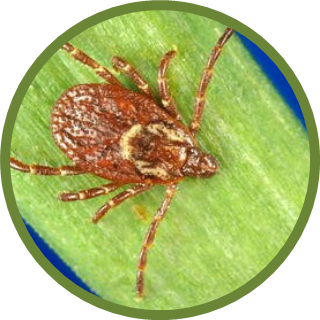Ticks are not insects and they do not have wings or antenna. Ticks are arachnids and are related to spiders, scorpions and mites. Ticks do not have a neck and cannot turn their heads to look at things like we can.
Lyme disease and other tick-borne diseases are infections caused by viruses, parasites and bacteria that can be spread through the bite of infected blacklegged ticks (Ixodes scapularis).
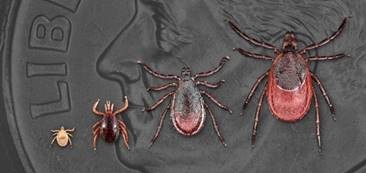
Ticks don’t jump or fly. They crawl to the tip of grasses or shrubs. They hold on to leaves and grass with their back legs and reach out with their front legs and grab onto an animal or person when they pass by. This is called questing. Sometimes they let go and simply free fall onto a passing host. They will wander on the host and look for a lovely spot to feed. They often attach behind ears and under arms.
Ticks want to suck your blood! Or the blood of deer, mice or other animals. Ticks need three separate blood meals during their life cycle.
Eggs hatch into tiny six-legged larva that will feed on mice and other small animals. After a delicious meal, they molt into an eight-legged nymph. Yup, they grew two additional legs.
A nymph is the size of a poppy seed, but that doesn’t slow them down. They will feed on small and large animals, which means you or your pet could be their next meal! After feeding a nymph will molt into an adult male or female tick.
Adult ticks are the size of a sesame seed. Female ticks are the hungry ones and they are looking for a tasty deer or other large animals. Female ticks, with the help of a male companion, will lay eggs after feeding.
For the most part ticks are inactive throughout the winter. They begin to look for their next meal as temperature warm up. Ticks are most active when temperatures rise above 4℃. Nymphs are usually active during the spring and summer months and adult ticks are most active during the spring and fall months.
If temperatures become too hot, ticks are at risk of drying out (desiccation). Habitats with leaf litter in a forest and shrubs at the edges of forest provide protection for ticks.
The risk of being bitten by a black legged tick is highest in areas where tick populations are established.
Larva, nymph, adult male and adult female blacklegged tick with dime for size comparison. Source: US Centers for Disease Control and Prevention (CDC), Atlanta, GA, USA. Ticks Image Gallery. Photo ID All life stages of Ixodes scapularis.
Unlike a mosquito or other biting insects, ticks will feed for long periods of time. For days. Ticks have a secret weapon – their saliva has anaesthetic properties so you can’t feel any pain when they slowly insert their mouth parts deep into your skin. Ticks firmly attach by their long hypostome that is covered in small barbs or teeth that curve backward. Ticks also secrete an anticoagulant and can suck blood over the next several days.
Ticks get larger when they are feeding, called engorgement. Nymph ticks will still be small when fully fed but adult females can swell to the size of a small grape.
Blacklegged ticks need to be attached and feeding on people to spread diseases.
There are several tick species in New Brunswick, including Ixodes scapularis (blacklegged tick), Ixodes cookei (groundhog tick), Dermacentor variabilis (American dog tick), and Dermacentor albipictus (moose or winter tick).
You can identify ticks by taking a photo and sending it to ETick.ca, an image-based identification platform. Maybe you will find a species never found before!
Testing a tick that has bitten an individual does not help guide the diagnosis and treatment of Lyme disease and other tick borne illness. This is because a person may have been unknowingly bitten by another infected tick that was not found. As part of tick surveillance activities, ticks can be tested to identify what bacteria and viruses are occurring.
What do ticks look like
COMMON NAME: Blacklegged tick
SCIENTIFIC NAME: Ixodes scapularis
DIET: Sanguivore (eating blood)
FAVORITE FOOD: Variety of small and large animals including people
SIZE: 3-5 mm long (and can become 10 mm long after feeding)
COLOR: Bright red with dark brown shield and long mouthparts
STATUS: Common in New Brunswick
ACTIVITY: Adults are most active in spring and summer months
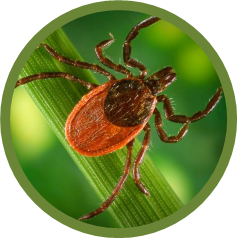
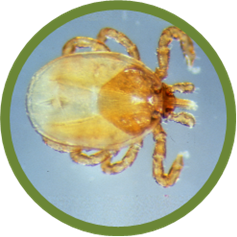
COMMON NAME: Groundhog Tick
SCIENTIFIC NAME: Ixodes cookei
DIET: Sanguivore (eating blood)
FAVORITE FOOD: Groundhogs, squirrels, other small animals and people
SIZE: 3-5 mm long (and can become larger after feeding)
COLOR: Tan to reddish tan with darker shield and long mouthparts
STATUS: Common in New Brunswick
ACTIVITY: Adults are most active in summer months
COMMON NAME: American Dog Tick
SCIENTIFIC NAME: Dermacentor variabilis
DIET: Sanguivore (eating blood)
FAVORITE FOOD: Dogs. Other large animals including people
SIZE: 3-7 mm long (and can become larger after feeding)
COLOR: Looks like Moose Tick. Brown with white markings on shield and short mouthparts
STATUS: Common in New Brunswick
ACTIVITY: Adults are most active in spring and summer months
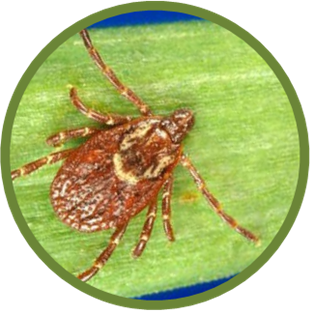
COMMON NAME: Moose or Winter tick
SCIENTIFIC NAME: Dermacentor albipictus
DIET: Sanguivore (eating blood)
FAVORITE FOOD: Moose and deer
SIZE: 3-7 mm long (and can become 10 mm long after feeding)
COLOR: Looks like American Dog Tick. Dark brown with white markings on shield and short mouthparts
STATUS: Common in New Brunswick
ACTIVITY: Spend life cycle on host. Large numbers of larvae may be encountered in fall, particularly in habitat where moose are found.
